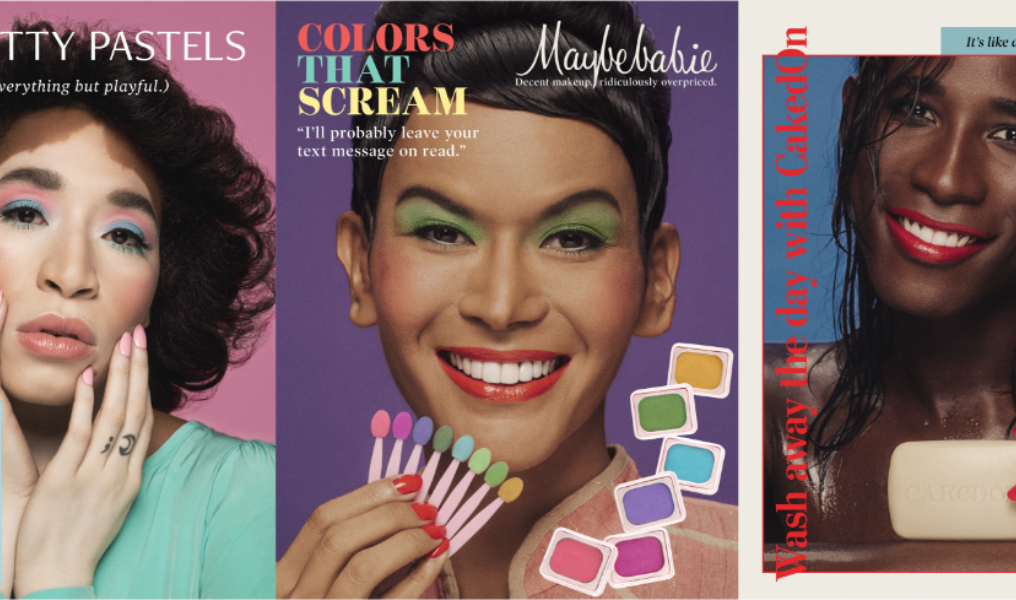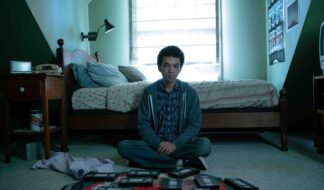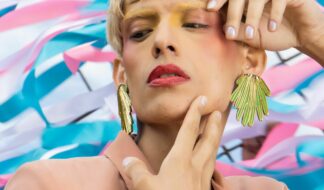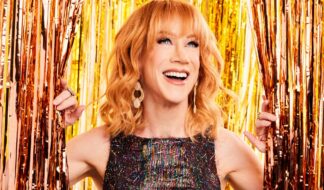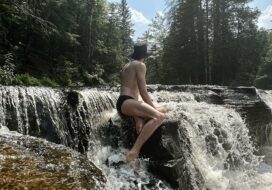Without dispute, the '70s were an iconic fashion decade. Tie-dye, floral, bell-bottoms, mini (and maxi) dresses. It's not hard to pick out a seminal trend whose influence can be seen even in modern-day wear.
But despite its fun fashion, the decade idealized white standards of beauty, largely leaving out anyone who didn't meet the mold of skinny, cisgender female models.
Now, with "Prim-n-Poppin," which officially launches today, New York-based photographer Julia Comita and makeup artist Brenna Drury have imagined a world that better reflects the diverse world we live in.
The online project is a series of reimagined vintage magazine ads that includes models of various races from the body modification, vitiligo and body positivity communities. But it's not only representative of physical diversity. "Prim-n-Poppin" showcases five reimagined vintage beauty ads that also highlight models with ranging sexual orientations and gender identities.
It includes detailed interviews with each model — like Jesi Taylor Cruz, who grew up in Michigan, between Kalamazoo and Union Pier — and allows viewers to access a detailed resource list of allied companies and organizations that value beauty just as much as the emotional health and well-being of the people who are interested in fashion today, unlike the antiquated original source material.
Recently, Comita and Drury shared why inclusivity is as important as ever in fashion today, what it was like breaking modern makeup rules to create the project, and why seeing diverse representation in these vintage ads brought out an emotional response in both the project creators and the participating models.
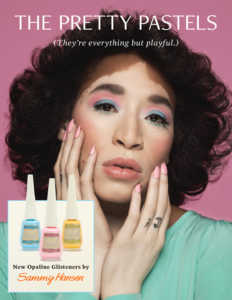
Jesi Taylor Cruz. Courtesy photo.
Where did the name for "Prim-n-Poppin" come from? It's so fun and catchy.
Julia Comita: We like that name because "prim" is sort of alluding to the vintage portion of it. You know, more old-school and more proper, if you will. And "poppin'" is more alluding to present-day. It is a combination of the two. And it's just a fun title.
Brenna Drury: We did have a little focus group when it came to all of the titles. We got a group of creatives together and were bouncing ideas and (fake featured brand) names around, and the ones that we came up with really stuck and as soon as it came up, it was just, "Yes!"
Comita: We took real brands and tried to come up with our own, more tongue-in-cheek names that referenced real brands for whoever gets it.
What was the process of coming up with the idea?
Drury: We met through Instagram. I messaged her to collaborate. That was in early summer 2019 and I made a few mood boards, three of which were more along the beauty lines of pops of color and fresh skin. And then I threw in the vintage advertisements, which were just colorful fun. We started with that and agreed that we would like to do something a little bit different. And then, while looking through the vintage advertisements, we were picking up on the undertones like how non-inclusive they were, and just the more conversations we had, we were able to narrow it down to exactly what we wanted it to do.

Coral Johnson-McDaniel (left) and Ava Trilling. Courtesy photo.
Once the project was completed, what did you feel when you saw all the diverse faces represented in this traditionally exclusive way?
Comita: Very emotional. I don't know, it just makes me smile. If I look at all the original ads all together, from a surface-level perspective I might be like, "Oh, those are funny." But if I really look at them, I don't feel good because it doesn't feel correct. It feels very one-sided. So, seeing all of the faces together now, it makes me feel kind of emotional because this is the world we live in. Especially in New York City, we go out the door and we see so many different kinds of people. These are our friends.
Drury: We would love to expand on the project, of course, but it's a start to seeing the advertisements as how I see my world today, which makes me very happy.
It's great that the concept of diversity extended out to sexual orientation and gender identity as well. How did you find the LGBTQ models featured in "Prim-n-Poppin"?
Comita: There are a number of great agencies out here that are catering to a more diverse group of people. There's places like We Speak that we pulled talent from. They even have a whole category in their roster for fluid. And Slay was another agency that we cast from; Slay is the first exclusively transgender agency. I actually didn't know those agencies before we did this project. This was something Brenna and I had talked about. Brenna did a lot of research and sent some agencies to my attention and we were able to find everyone except for Cory (Walker), who did the soap ad, who I was referred to from another project a few months before who I shot with. I just really loved their energy and they photograph really well.
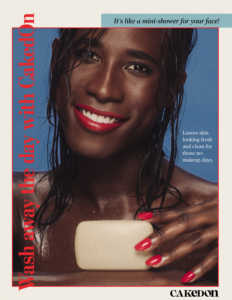
Cory Walker. Courtesy photo.
Was there an artistic challenge that was unique to shooting this project?
Drury: For me, I wouldn't say it was a challenge, but the makeup aesthetic was obviously different during that time, and the way that I like to do makeup now is skin-forward. Back then it was more caked on, so it was an adjustment to put that much makeup on my clients. I knew that it would read how I wanted it to read, but that was the only thing for me.
Comita: I don't know if I would call this an artistic challenge per se, but I guess one of the things that was different about this project was making sure that everybody was being a little bit silly or over the top. We're not asking them to model to make themselves the best they can look, it's more about, "Let's get the feeling across of this picture and what we're trying to communicate.
Drury: Posing was something that we talked a lot about, whether it was like they were selling the cellphone and it was like this (pained smile). Now, it's just more casual, but I feel like there was a period of adjustment when the talent were getting out of their normal modeling state and being just, like, extra (laughs).
So did you find yourself breaking all the modern makeup rules of today?
Drury: (Laughs) Well, just eyeshadow all the way up to the brows that's the same color — these things that I would not do to my clients right now. But that was also the fun of it, to do something like that.
Comita: Totally. There are few times where you want to go balls to the wall with everything. Things are more understated now because it can look really tacky (laughs), but in this case, that was the most appropriate direction. So I think we were all doing things stylistically that we wouldn't be doing otherwise.
Drury: In Kaguya, the one where she had all of the makeup (in her hand), a few of the people that we showed it to once it was done, there was a question of like, "Is that rubber band supposed to be there?" It's funny because that's not something you would find now, but in the original ad, that's exactly what it was.
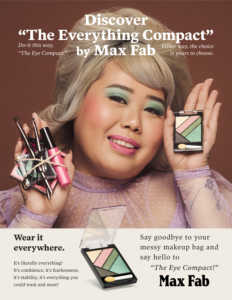
Kaguya. Courtesy photo.
(Laughs) Right, how else could it have stayed together without the rubber band? What was the shooting process like?
Comita: It was a long process. We actually shot everything in one day. We originally were going to do six ads, and then it was just too many. We cut it to five, and we did it all in one day. The biggest challenge with that was at first getting a team together — six models plus hair, styling, prop stylist. We did shoot all the main content in one day in late September 2019 and then we had a few months to get the creatives together, start talking with casting, getting the agencies, find the rest of the team and then shoot it. But after that it was a good six months of back-and-forth with the copywriter who wrote all the taglines and figuring out all the brand names, which Brenna mentioned was a group effort.
Having the retouching done so that everything can look vintage-feeling, and then also working with an art director on the layout of all the product shots. And the product shots were all shot separately, by the way. The ones they were actually holding were shot and branded independently at a later date, so it was a many-, many-, many-step process with lots of rounds of revision. And we asked for other people's feedback, "Do you get it? Is this funny?" All in all, from when we actually met, it was like nine months. But after we shot it, it was at least six months after that to get everything together. We finished in the middle of lockdown.
Do you think had the pandemic not happened it would have come out last year?
Comita: Who knows? The pandemic and the protests and everything that was going on right around when we did finish, there were moments when we just felt that it was not appropriate for us to put this out because there are too many other things going on that are really important and newsworthy. Also, we felt like we wanted to present the best possible product, which in this case is also now including a website. Originally that's not something we planned on doing, but now we have a website that's going to be launched as well that has interviews with all of our talent and a big list of resources that Brenna's been working really hard on that includes inclusive modeling agencies and brands that are ally brands catering to the LGBTQ community, for example.
Drury: And we also have some more serious resources for the trans community, the LGBT community, the native community. We wanted to make sure that our viewers know that although beauty and makeup and hair is fun, we know that a lot of people are just struggling to live. We wanted to make sure that they feel seen and that they could reach out if they had a question about resources or if they recognize that.
What do you hope will be the first impressions of people who get to really sit down and take a look at this? Do you think they'll be tricked at first into thinking it's a real vintage ad?
Comita: That would be cool! (Laughs) I actually shared this with a friend last night, and he is in the queer community as well and he's Black. And he was saying that, for him, looking at the pictures it was as if they had always been there. And that was a really special response. I would love for that to be the case. It would be great if people looked at them and thought, "I could have seen this then."
Drury: I would (love) people seeing it to feel a sense of comfort.
Comita: And community. I think we've said this several times already, but just having someone view it and feel seen in it and feel like they relate to that.
Drury: We also talked about getting conversations going. And with being in the queer community myself, I've realized how important representation was in my upbringing because I didn't have a lot of it and I was affected by that and I didn't realize I was affected until I was older. I would like more people to have conversations about how important it is so that it could reach big brands and so that it could be something that's really high up on the list when they're casting, and when they're coming up with their creative briefs of how it's going to affect people. That needs to be part of the conversation.
Find out more about "Prim-n-Poppin'," the featured models and its creators online at prim-poppin.com.
